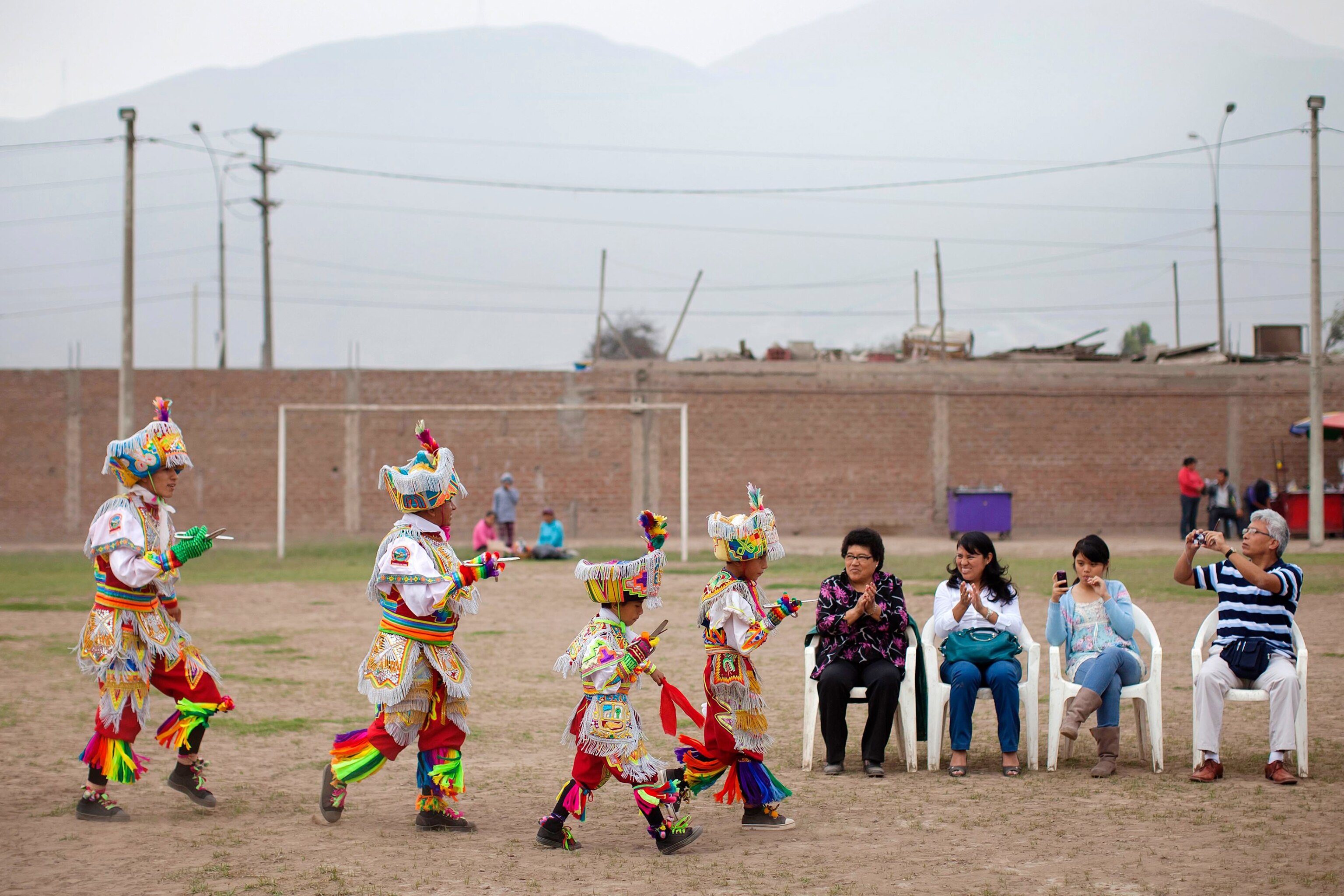



Meet the Men Who Literally Dance With Scissors
Forget running with scissors; this competitive Quechua dance takes danger to the next level. (Don’t try this at home.)
For more than 500 years, the heart-stopping clanging of the Danza de Tijeras has echoed throughout the Andean mountains.
Named for the pair of iron rods each dancer wields in his right hand, the scissors dance is traditionally performed by men from Quechua villages in south-central Peru. The ritual is a form of prayer celebrating the Andean divinities tied to nature, like the sun (Inti) and moon (Quilla).
Joined by a violinist and harpist, the dancer forms a cuadrilla, or team, to represent their community in a duel. Two or more cuadrillas compete through a series of acrobatics, step-dancing, aerial jumps, and choreographed moves in synchrony with the musicians–all whilst sounding the oversized scissors.
The competition, which can last up to 10 hours, assesses physical ability, instrument quality, and musician expertise to determine the winner. Because the rhythm and tempo of the music is constantly changing, no two dances are identical.

Perhaps most striking are the dancers elaborate outfits, embellished with golden fringes, multicolored sequins, and small mirrors. The dancers themselves craft the 33-pound costumes and embroider their spirit names and various elements of nature into the fabric. Their large, intricately decorated headdresses shield the upper half of their face from observers, adding a quality of otherworldliness.
Even though the dancers start training as children, it takes years to master the physically demanding choreography. As a rite of passage, the young Quechuas—claiming to be the children of Wamanis, or mountain spirits—receive a name associated with one of the spirits so they can dance under their protection. This physical and spiritual knowledge is passed from master to student in each Quechua community to ensure the livelihood of the extraordinary dance generation after generation. In 2010, the scissors dance was added to the UNESCO List of the Intangible Cultural Heritage of Humanity.
The origin of the dance is uncertain, however some believe it was created in reaction against colonialism and the repression of indigenous ideals. During the 1500s, the dancers were persecuted by Christians because the dance was believed to be a manifestation of dark magic. The performers were considered supaypa guagua–sons of the devil–who refused to dispel their ancient practices and made a pact with the devil to get such abilities. Though the dance is now accepted and performed at Christian celebrations, dancers are forbidden to enter a church while in costume to this day.
You May Also Like
Go Further
Animals
- Octopuses have a lot of secrets. Can you guess 8 of them?
- Animals
- Feature
Octopuses have a lot of secrets. Can you guess 8 of them? - This biologist and her rescue dog help protect bears in the AndesThis biologist and her rescue dog help protect bears in the Andes
- An octopus invited this writer into her tank—and her secret worldAn octopus invited this writer into her tank—and her secret world
- Peace-loving bonobos are more aggressive than we thoughtPeace-loving bonobos are more aggressive than we thought
Environment
- Listen to 30 years of climate change transformed into haunting musicListen to 30 years of climate change transformed into haunting music
- This ancient society tried to stop El Niño—with child sacrificeThis ancient society tried to stop El Niño—with child sacrifice
- U.S. plans to clean its drinking water. What does that mean?U.S. plans to clean its drinking water. What does that mean?
- Food systems: supporting the triangle of food security, Video Story
- Paid Content
Food systems: supporting the triangle of food security - Will we ever solve the mystery of the Mima mounds?Will we ever solve the mystery of the Mima mounds?
History & Culture
- Strange clues in a Maya temple reveal a fiery political dramaStrange clues in a Maya temple reveal a fiery political drama
- How technology is revealing secrets in these ancient scrollsHow technology is revealing secrets in these ancient scrolls
- Pilgrimages aren’t just spiritual anymore. They’re a workout.Pilgrimages aren’t just spiritual anymore. They’re a workout.
- This ancient society tried to stop El Niño—with child sacrificeThis ancient society tried to stop El Niño—with child sacrifice
- This ancient cure was just revived in a lab. Does it work?This ancient cure was just revived in a lab. Does it work?
Science
- The unexpected health benefits of Ozempic and MounjaroThe unexpected health benefits of Ozempic and Mounjaro
- Do you have an inner monologue? Here’s what it reveals about you.Do you have an inner monologue? Here’s what it reveals about you.
- Jupiter’s volcanic moon Io has been erupting for billions of yearsJupiter’s volcanic moon Io has been erupting for billions of years
- This 80-foot-long sea monster was the killer whale of its timeThis 80-foot-long sea monster was the killer whale of its time
Travel
- How to plan an epic summer trip to a national parkHow to plan an epic summer trip to a national park
- This town is the Alps' first European Capital of CultureThis town is the Alps' first European Capital of Culture
- This royal city lies in the shadow of Kuala LumpurThis royal city lies in the shadow of Kuala Lumpur
- This author tells the story of crypto-trading Mongolian nomadsThis author tells the story of crypto-trading Mongolian nomads




